NationalEclipse.com | Jan 14, 2021 | National Eclipse Blog
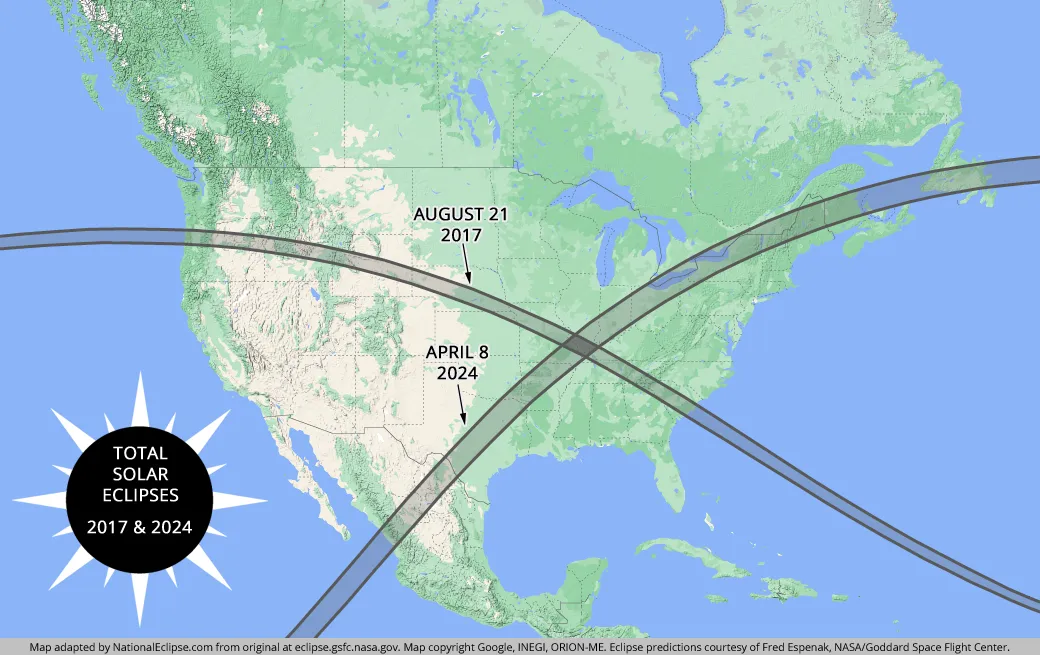
Back in 2016, we posted a short article about how the path of the 2017 total solar eclipse would be crossed by the path of the 2024 total solar eclipse, creating a zone of overlapping totality spanning parts of Missouri, Illinois, and Kentucky. Even before the 2017 eclipse occurred, locals were calling that area the "Eclipse Crossroads of America." Conceivably, we noted, someone could plan to see two total solar eclipses from the same place in the span of only seven years.
Most people think of total solar eclipses as extremely rare events, but a total eclipse occurs somewhere in the world, on average, about once every 18 months. If you look at a map that details even a relatively short timespan, like 100 years, you'll see path crossings all over the place. In 2016, we ended our blog post with a note that a total of eight total solar eclipses would occur in the contiguous U.S. this century and we promised to dedicate a future blog post to discussing when and where those eclipses would cross paths.
Some of those upcoming eclipses will probably occur far beyond your lifetime. Others will happen sooner. And, like with the 2017 and 2024 total solar eclipses, some of them will cross paths within relatively short time spans of each other. What follows is our long-overdue look at every one of those 21st century eclipse path meet-ups.
Total Solar Eclipse of August 21, 2017
The total solar eclipse that occurred on August 21, 2017, was noteworthy for several reasons. It was the first total solar eclipse of the 21st century in America. It was the first total solar eclipse to cross the U.S. from coast to coast in nearly 100 years. It was the first total solar eclipse exclusive to U.S. soil since before America was even founded. And, of course, its path would be crossed in only seven short years by that of another total solar eclipse, on April 8, 2024. As already mentioned, the 2017 and 2024 eclipses cross paths to create an overlapping totality zone of roughly 9,000 square miles in Missouri, Illinois, and Kentucky, with the centerlines of those two eclipse paths meeting up in southern Illinois.
But the 2024 eclipse isn't the only one that crosses the path of the 2017 eclipse in America this century. There are two others. A total solar eclipse on March 30, 2052, will cross the path of the 2017 eclipse along the coast of South Carolina, with Charleston inside the totality overlap zone. And on May 11, 2078, 61 years after the 2017 eclipse occurred, its path will be crossed by a total solar eclipse in South Carolina and Georgia.
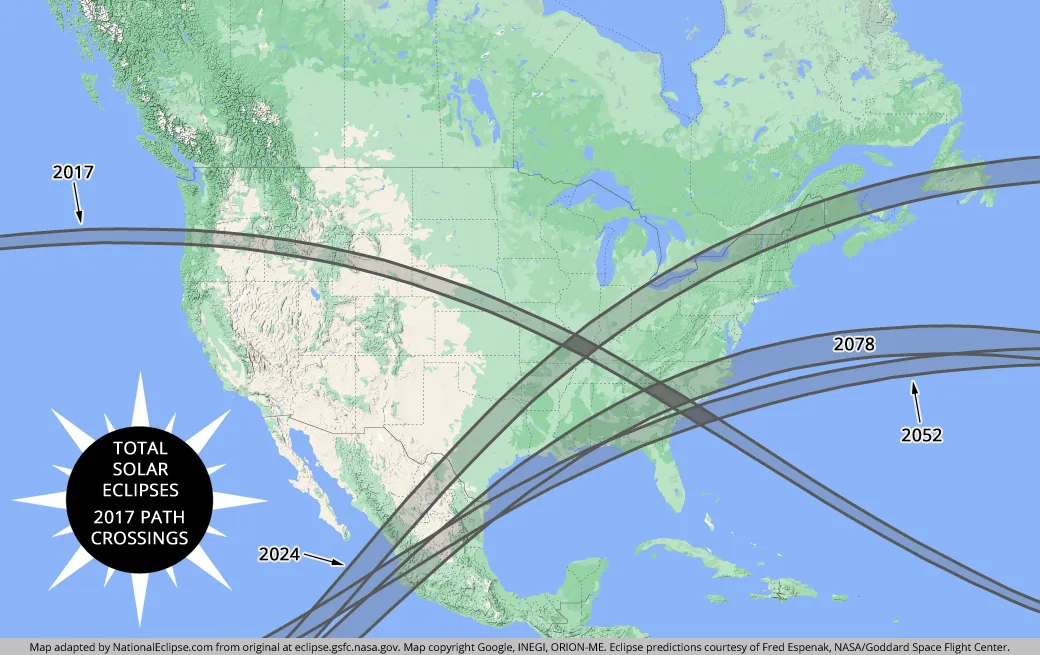
Total Solar Eclipse of April 8, 2024
The next total solar eclipse in the U.S. will occur on April 8, 2024, traveling through the country from Texas to Maine. In some ways, the 2024 eclipse promises to be even more spectacular than in 2017, crossing over or coming close to more major cities and with a maximum duration of totality that's almost two minutes longer.
After the 2024 eclipse occurs, when it will cross the path of the 2017 eclipse, it will itself be intersected by two future eclipses. The first path crossing occurs 21 years later on August 12, 2045, in Arkansas and Oklahoma. The second occurs after a 75-year wait on September 14, 2099, in Ohio and Indiana. It wouldn't be unreasonable to expect that a young person who witnessed totality from one of those states in 2024 could see another total solar eclipse from the exact same place as a senior citizen in the last year of the century.
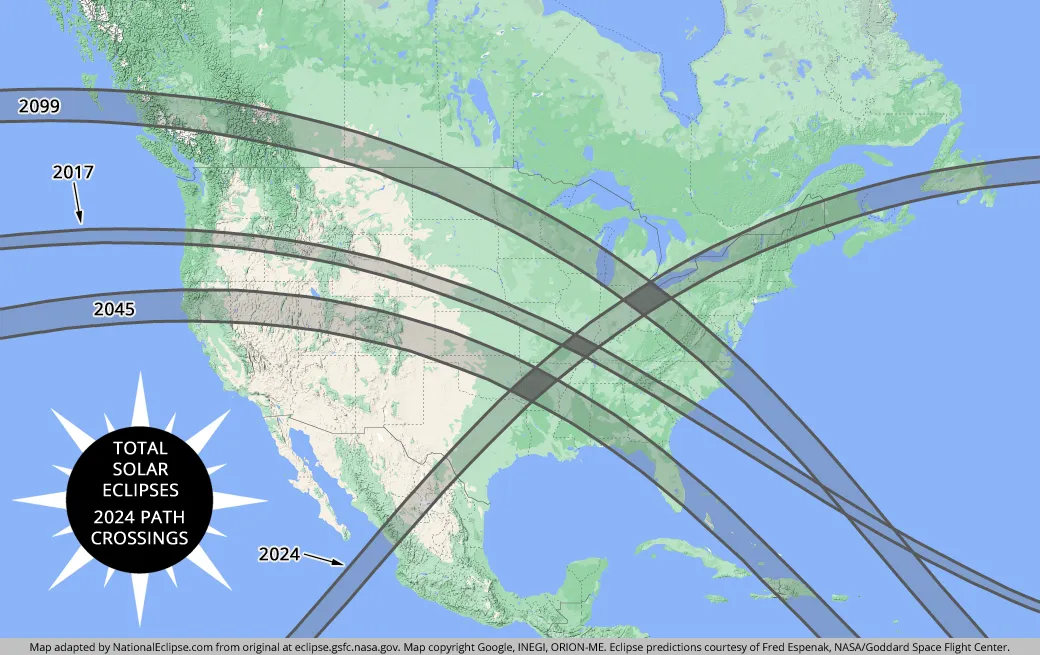
Total Solar Eclipse of August 23, 2044
On August 23, 2044, a total solar eclipse will sweep down from Canada into the U.S., terminating its path in Montana and North Dakota. Usually, the path of a total solar eclipse terminates at sunset. In this case, since the path terminates over land, the people of Montana and North Dakota will have a chance to see a relatively rare "sunset eclipse." Although difficult to view unless you have a clear line of sight to the horizon, the effect can be fantastic.
Since the 2044 eclipse doesn't cover much ground in the U.S., never making it very far beyond the U.S.-Canada border, it's crossed in the U.S. by only one other 21st century eclipse, 55 years later on September 14, 2099. The 2044 eclipse traces a very wide path, so the path crossing itself is quite large, but most of it is located in Canada. In the U.S., a zone of overlapping totality can be found in the northeast corner of Montana and the northwest corner of North Dakota.
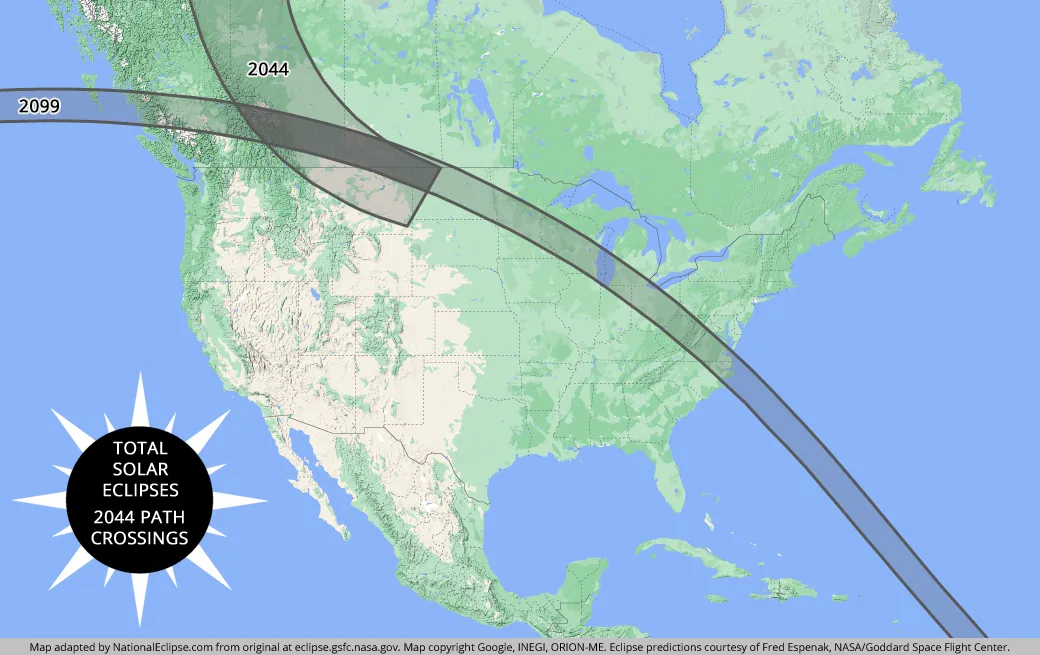
Total Solar Eclipse of August 12, 2045
The total solar eclipse that will occur in the U.S. on August 12, 2045, could arguably be considered the best of the century. Like the 2017 eclipse, it's a coast-to-coast event, beginning in California and ending in Florida. It crosses over several major cities, including Salt Lake City, Denver, Oklahoma City, Orlando, Tampa, and Miami. It even passes over Walt Disney World. But the most exciting aspect of the 2045 eclipse is its maximum duration of totality. At the point of greatest duration, the Sun will go dark on August 12, 2045, for a whopping six minutes and six seconds, only about 90 seconds short of the theoretical maximum for any total solar eclipse on Earth.
After the 2045 eclipse sweeps across the nation, crossing the path of the 2024 eclipse in the process, its own path will in turn be crossed by two additional total solar eclipses. The first crossing occurs just seven years later, on March 30, 2052, matching the 2017/2024 path crossing timespan for the shortest of the century. The overlap zone is located in Alabama, Georgia, and along the Florida panhandle, with Tallahassee receiving a double dose of darkness. Perhaps this region will be touted as the next "Eclipse Crossroads of America" in the years leading up to the 2045 eclipse. Later in the century, on May 11, 2078, a second path crossing occurs just northwest of the first, with Mississippi joining Alabama, Georgia, and Florida in the overlap zone.
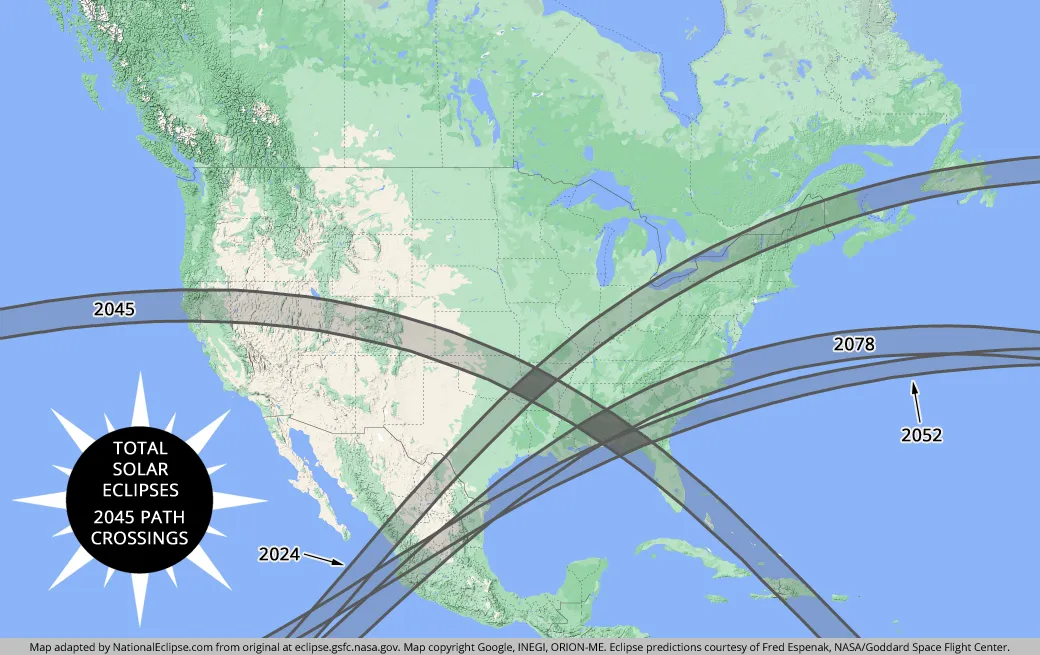
Total Solar Eclipse of March 30, 2052
On March 30, 2052, a total solar eclipse will skim parts of six southern states: Texas, Louisiana, Alabama, Florida, Georgia, and South Carolina. Indeed, the 2052 eclipse continues a trend that highlights the southeastern U.S. as a 21st century eclipse hotspot. No other region of the country will see more total solar eclipses over the next 100 years than the Southeast.
The 2052 eclipse crosses the paths of the 2017 and 2045 eclipses and then changes its role from crosser to crossee when, 26 years later, it's crossed by the path of another 21st century eclipse. That path crossing occurs on May 11, 2078, at the extreme southern tip of Texas, through a narrow strip of the Mississippi River Delta in Louisiana, and over tiny slices of land in Alabama and Florida.
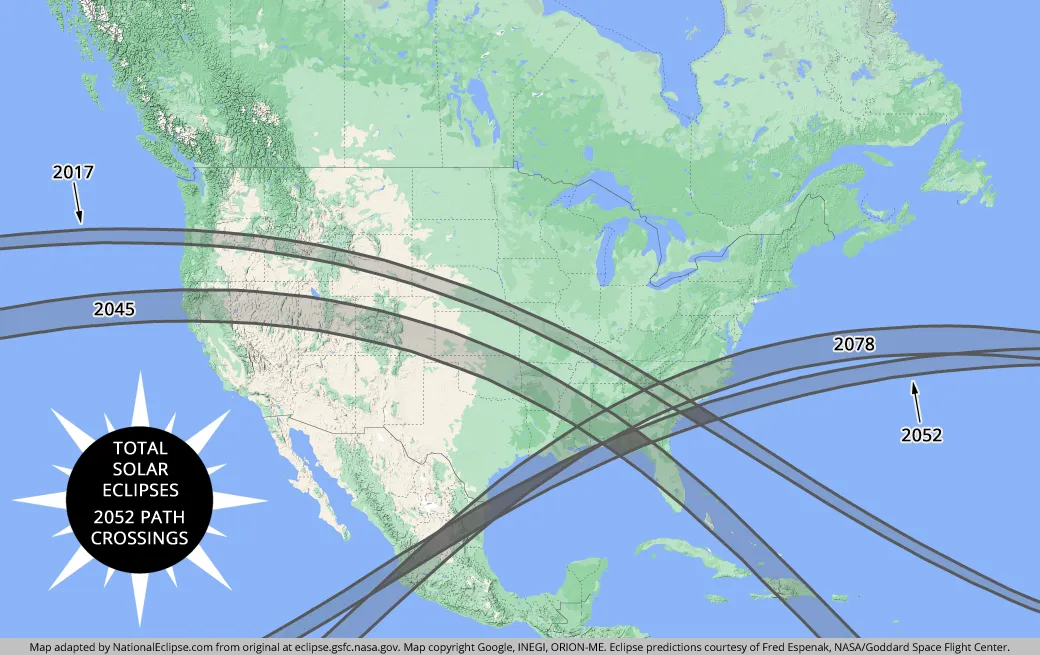
Total Solar Eclipse of May 11, 2078
The May 11, 2078, eclipse charts a path similar to that of the 2052 eclipse. It tracks from west to east and crosses over Texas, Louisiana, Mississippi, Alabama, Florida, Georgia, South Carolina, North Carolina, and Virginia. And, like the 2045 eclipse, it's a long one, with a maximum duration of totality that clocks in at five minutes and 40 seconds.
The 2078 eclipse also happens to be the only 21st century eclipse in the U.S. that crosses or is crossed by more than three other eclipses over U.S. soil this century. When it occurs, it crosses the paths of the 2017, 2045, and 2052 eclipses. And then, 21 years later, it's intersected by the path of a total solar eclipse on September 14, 2099. This time, the overlap is located along the coast of Virginia and North Carolina, with Norfolk and Virginia Beach inside the totality zone.

Total Solar Eclipse of May 1, 2079
While in 2044 a total solar eclipse terminates its path in the U.S., resulting in a rare "sunset eclipse," on May 1, 2079, a total solar eclipse commences its path in the U.S., offering viewers a rare "sunrise eclipse." The path of the 2079 eclipse begins in Pennsylvania and New Jersey and travels through New York, Connecticut, Rhode Island, Massachusetts, Vermont, New Hampshire, and Maine, with its centerline running directly through Long Island and Cape Cod, before looping through Canada and Greenland and up over the North Pole.
Since it quickly leaves the U.S. after covering a relatively small area of land, the 2079 eclipse is the lone total solar eclipse of the 21st century in the U.S. that neither crosses nor is crossed by another total solar eclipse path in the U.S. during those 100 years.
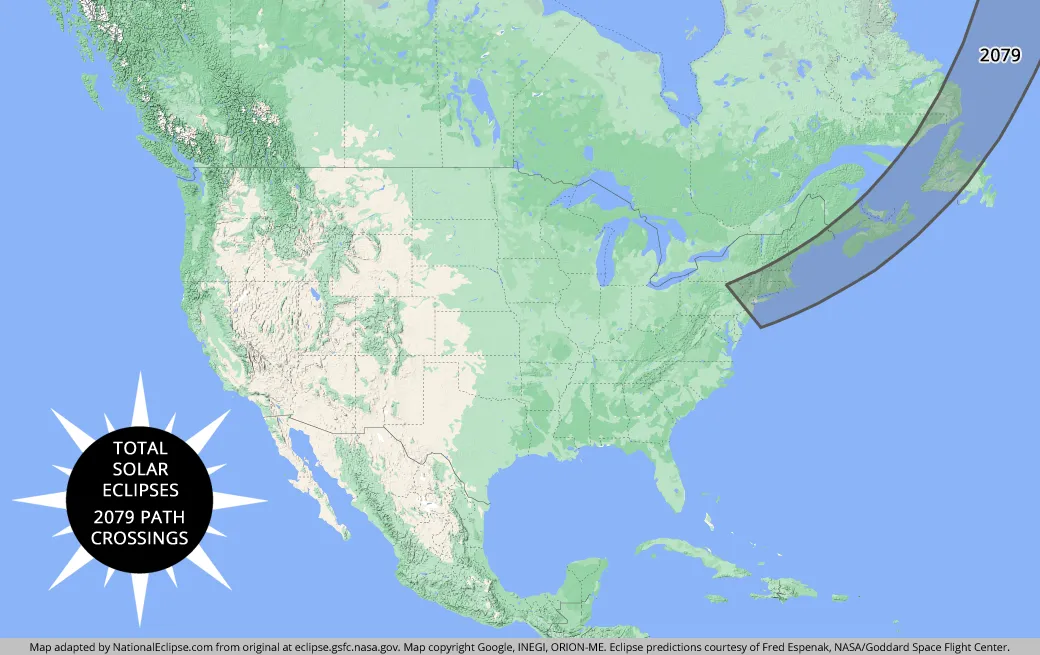
Total Solar Eclipse of September 14, 2099
On September 14, 2099, a total solar eclipse arcs down from Canada and races through 14 U.S. states in a southeasterly direction from Montana to North Carolina. Yet again, it's an eclipse that breaks the five-minute mark, with a maximum duration of totality of five minutes and 18 seconds.
The 2099 eclipse crosses the paths of the 2024, 2044, and 2078 eclipses. But, of course, as the last total solar eclipse of the 21st century in America, it isn't itself crossed by another total solar eclipse path during this 100-year period.
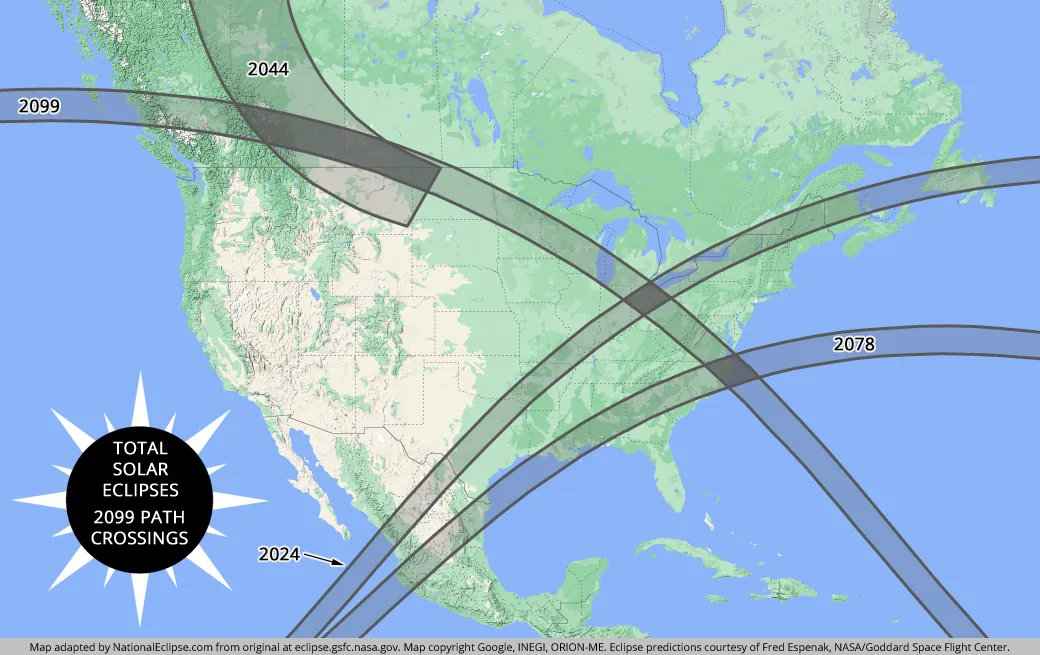
2023/2024 Path Crossing
One other 21st century path crossing in the U.S. deserves to be mentioned, because it's coming up soon. On October 14, 2023, an annular solar eclipse will occur in the U.S. An annular eclipse takes place when the Moon is too far away in its orbit around the Earth to completely obscure the Sun. Instead of totality, an annular eclipse results in what looks like a "ring of fire" in the sky. Although nowhere near as impressive as a total solar eclipse, most eclipse chasers consider annulars to be the next best thing. As is the case with total eclipses, annular eclipses have paths too, and the annular solar eclipse of October 14, 2023, will chart a narrow path of annularity across eight U.S. states from Oregon to Texas.
Texas is the place where the 2023 annular solar eclipse will be crossed just six months later by the path of the 2024 total solar eclipse. If you're so inclined, you could plan to see two solar eclipses, an annular and a total, from the exact same place in the span of only half a year. The overlap zone consists of a large diamond-shaped area in the Texas Hill Country to the west of San Antonio. The exact point where the centerlines of these two eclipses meet is near the tiny town of Vanderpool.
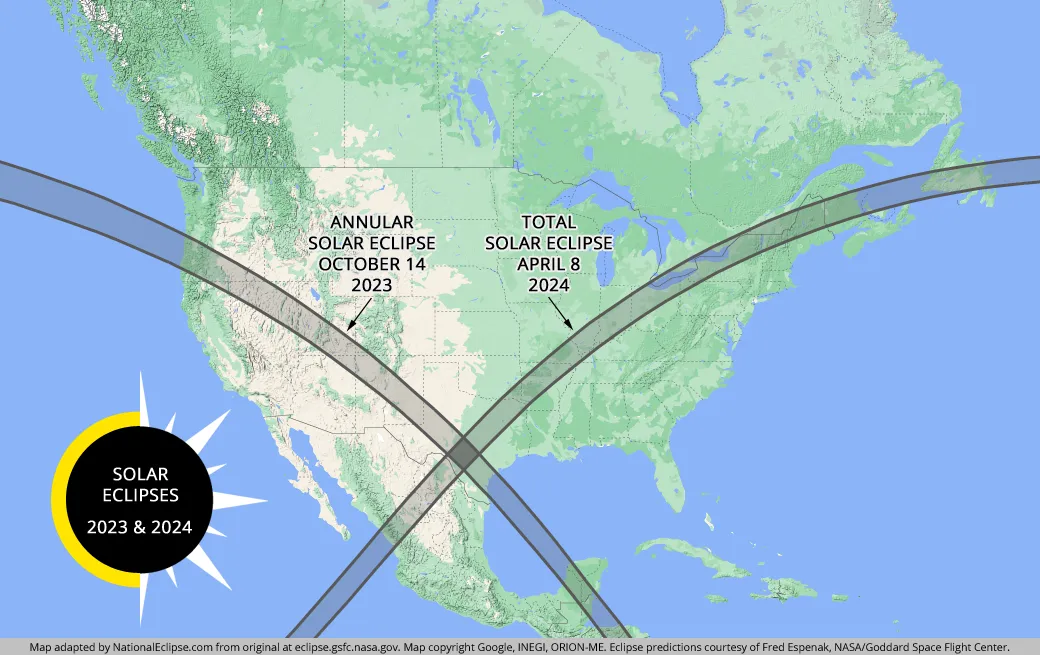
Last Words
The prevailing wisdom is that, on average, a total solar eclipse can be seen from the same place only once every 375 years. Of course, the key word here is average, and the timespan can also be a lot longer or a lot shorter. For example, there hasn't been a total solar eclipse over present-day Cincinnati in 626 years and there won't be another one until after the year 3000. On the other hand, as we've already seen, two different areas in the U.S. this century will twice experience totality during a seven-year period.
As to where eclipse paths cross, the answer is as varied as to that of when. Although solar eclipses are indeed cyclical, with similar eclipses occurring about every 18 years, no two solar eclipses are identical. The place over which two total solar eclipse paths intersect is virtually random.
However, because of the fact that eclipses do occur relatively frequently, the chances are fairly high that any one eclipse will cross or be crossed by the path of another inside a defined geographic area within a relatively short number of years. For the eight total solar eclipses in the contiguous U.S. during the 21st century, there are a total of 10 different path crossings. On average, an eclipse crosses or is crossed by 36 percent of the other eclipses, with a high of 57 percent (the 2078 eclipse) and a low of zero percent (the 2079 eclipse). Although it's a small sample size, if we assume that the data for other continents and centuries fall somewhere within the same ballpark, then it's safe to assert that total solar eclipse path crossings are quite common.
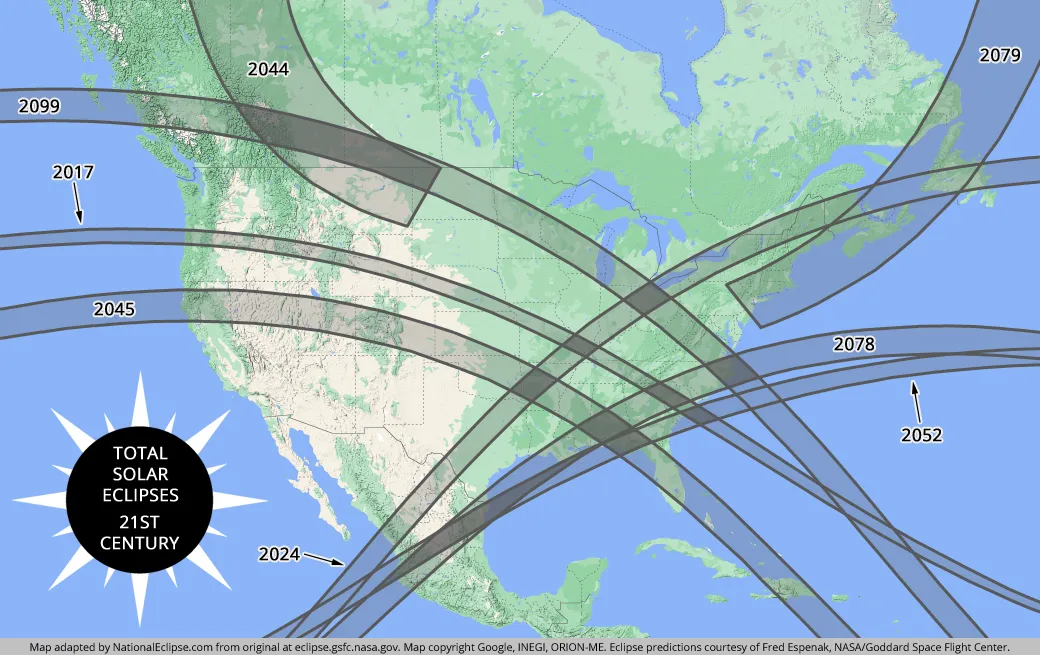
Finally, if we increase the timespan, path crossings become a virtual riot. if you like abstract art, you might enjoy looking at a map of the United States overlaid with every total solar eclipse path over the next 1,000 years. Even only a millennium's worth of total solar eclipse paths makes any meaningful naked eye analysis impossible.
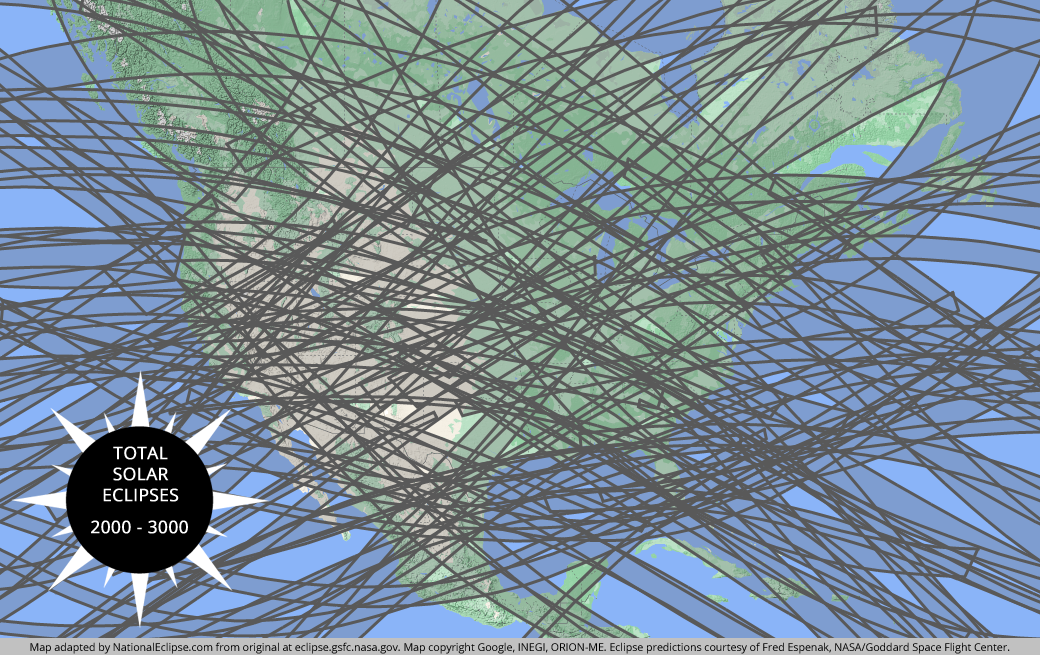
To see a time-lapse video of every total solar eclipse path over the present-day United States from 1000 to 3000, see our Eclipse Animations page.